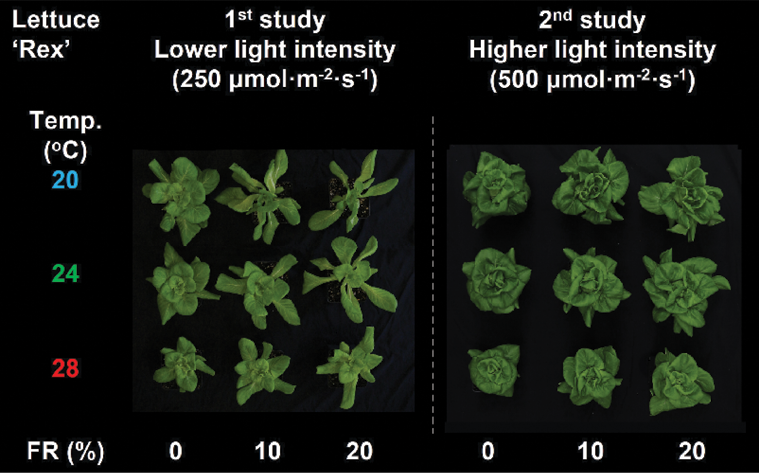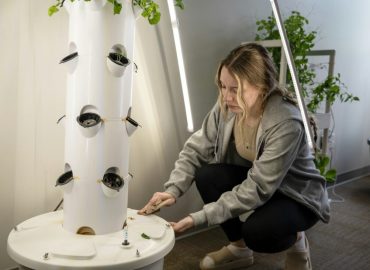Far Red Lighting & Temperature

Far-red light and temperature interactively regulate plant growth and morphology
Far red lighting & temperature | BY SANGJUN JEONG, ANTHONY PERCIVAL, JOSHUA CRAVER, GENHUA NIU AND SHUYANG ZHEN |
In controlled environmental agriculture, extensive efforts have focused on improving crop yield, quality, and uniformity through the application of electric lighting, either as a supplement or substitute for sunlight. Among various electric lighting sources, light-emitting diodes (LEDs) are gaining increasing popularity due to their energy efficiency, long lifespan, and low heat emission. Advancements in LED technology have also enabled precise regulation of light spectral quality, leading to the development of innovative cultivation strategies based on photobiological responses. One such strategy involves the application of far-red (FR) light (700-800 nm), which has been shown to be highly effective in regulating plant morphological traits and potentially improving crop yield in both greenhouse and vertical farming systems. Morphological changes induced by FR light, such as stem/leaf elongation and leaf expansion, can enhance photon capture and photosynthesis and consequently promote plant growth.
In addition to lighting control, increasing temperature has often been utilized to accelerate plant growth within an optimal temperature range. However, warm temperatures also induce morphological changes similar to those by FR light. The shared morphological characteristics suggest an interactive regulation of plant morphology and growth by both FR light and warm temperatures. As both temperature and light can be tightly controlled in controlled environment crop production, it is important to understand their interactive effects on plant growth and morphology to optimize production and prevent unintended losses.
To investigate the interactive effect between FR light and temperature on plant growth and morphology, a series of experiments were conducted collaboratively at Colorado State University (CSU) and Texas A&M University AgriLife Research. These experiments aimed to provide information applicable to both greenhouse and indoor crop production. In this first half of a two-part article, we will primarilcus on temperature management and the application of FR light for indoor crop production.

Experimental design
Two experiments were conducted in growth chambers at Texas A&M University in College Station. Our first study investigated the interactive effects between FR light and temperature on plant growth and morphology of Lettuce ‘Rex’ and basil ‘Genovese’. Three spectral treatments (0%FR, 10%FR, and 20%FR) were created by partially replacing red photons with FR photons under three temperature conditions (20° C, 24° C and 28° C). All treatments had the same total photon flux density (TPFD; 400-800 nm) of 250 μmol·m-2·s-1 (typical light intensity used for leafy greens in vertical farms) with a 12-h photoperiod [daily light integral (DLI) of 10.8 mol·m-2·d-1]. In a second study, we further investigated if the interactive effects between FR and temperature on plant growth and morphology were dependent on light intensity. We doubled the light intensity (TPFD increased from 250 to 500 μmol·m-2·s-1) while keeping all other experimental conditions the same.
In both studies, seeds were sown in 1.6 L square plastic pots in a greenhouse. Seedlings were moved to chambers for treatments six days after germination. At harvest (20 – 30 days after treatment), fresh and dry weights and morphological data, including leaf number, leaf length and width, plant height and width, and total leaf area, were collected.

Research results
The effects of FR light on plant growth and morphology are dependent on temperature
Warmer temperature accelerated plant growth rate and increased shoot dry weight in both lettuce and basil. Increasing temperature from 20 °C to 28 °C caused shoot dry weight to increase by 93% in lettuce and by 498% in basil at 0%FR. However, the effect of FR light on plant biomass was dependent on temperature conditions (Fig. 1). For example, as FR percentage increased from 0% to 20%, lettuce shoot dry weight significantly increased by 26% at a cool temperature of 20° C but decreased by 32% at a high temperature of 28° C. In basil, increasing FR light from 0 to 20% significantly increased shoot dry weight by 49% at cooler temperatures (20-24° C) but had no effect on plant biomass at 28° C. The effect of FR light and temperature on total leaf area was similar to that of shoot dry weight in both species. These interactive effects between FR and temperature indicate that the temperature of the growing environment should be carefully considered when applying FR light in indoor farms.
The interactive effect between FR and temperature diminishes with increasing light intensity
When light intensity increased from 250 μmol·m-2·s-1 to 500 μmol·m-2·s-1, a particularly interesting observation was that the interactive effect between FR and temperature on plant growth and morphology diminished. In both lettuce and basil, total leaf area and shoot dry weight consistently increased with increasing FR light regardless of temperature at a higher TPFD of 500 μmol·m-2·s-1, whereas FR light promoted leaf expansion only at cooler temperatures (20-24° C) at TPFD of 250 μmol·m-2·s-1 (Fig. 2). These results suggest that environmental factors (i.e., FR light, temperature, and light intensity) interactively regulate plant growth and morphology, highlighting the importance of co-optimizing multiple environmental factors to optimize crop production.
Recommendations for temperature control and far-red application in indoor production
We found that increasing temperature within an optimal range is effective in improving crop yield. However, we observed a decrease in plant biomass when applying FR light under warm temperature (28° C), especially under lower light intensities. To prevent unintended crop yield losses, we recommend limiting the use of FR light to cooler temperature conditions (20-24° C) when growing crop under relatively low light intensities that are typically used in indoor farms (around 250 μmol·m-2·s-1).
Additionally, our study revealed the interactive effect between FR light and temperature diminishes as light intensity increases. Applying FR light (up to 20% in this study) consistently increased growth of both lettuce and basil regardless of temperature conditions at a higher light intensity of 500 μmol·m-2·s-1. When higher light intensity is used for crop cultivation, FR light could be applied at a wider temperature range to promote plant growth. We suggest that further studies should be conducted to examine crop-specific responses to FR light, temperature, and light intensity.
Joshua Craver is an assistant professor and Anthony Percival is a grad student at CSU; Shuyang Zhen is an assistant professor, Genhua Niu is a professor and Sangjun Jeong is a student at Texas A&M.
Original Article: https://www.producegrower.com/article/far-red-light-temperature-interactively-plant-growth-cea/
The post Far Red Lighting & Temperature appeared first on GROZINE.


